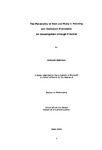The Materiality of Text and Body in Painting and Darkroom Processes: An Investigation through Practice
| dc.contributor.author | Robinson, Deborah | |
| dc.contributor.other | Faculty of Arts, Humanities and Business | en_US |
| dc.date.accessioned | 2013-09-16T10:12:04Z | |
| dc.date.available | 2013-09-16T10:12:04Z | |
| dc.date.issued | 2003 | |
| dc.identifier | NOT AVAILABLE | en_US |
| dc.identifier.uri | http://hdl.handle.net/10026.1/1738 | |
| dc.description | Merged with duplicate record 10026.1/567 on 14.03.2017 by CS (TIS) | |
| dc.description.abstract |
This research study ennploys practice-based strategies through which material processes might be opened to new meaning in relation to the feminine. The purpose of the written research component is to track the material processes constituting a significant part of the research findings. Beginning with historical research into artistic and critical responses to Helen Frankenthaler's painting, Mountains and Sea, I argue that unacknowledged male desire distorted and consequently marginalised reception of her work. I then work with the painting processes innovated by Frankenthaler and relate these to a range of feminist ideas relating to the corporeal, especially those with origins in Irigaray's writings of the 1980s. The research involves three discrete bodies of work. The first, Inscriptions, explores the relation between visual processes and textual ideas. The second, Screen / Paintings, is a re-enactment of formalist decisions that attempts to recover the body in the work. The third, Photoworks, is an attempt to 'jam' vision whilst redirecting process through the unconscious and touch. Each body of work gave rise to a practice text. In these texts, ideas that informed or were triggered by making are unearthed. Material processes are understood as a reiteration of themes (or issues) in relation to the feminine. These include: the relation between text and the visual, corporeality in making, the interplay between conscious and unconscious processes, and control / uncontrol. These ideas are reformulated in each body of made work. My approach maps out a method of working that is non-predictive and deliberately situated on the margins of control. | en_US |
| dc.language.iso | en | en_US |
| dc.publisher | University of Plymouth | en_US |
| dc.title | The Materiality of Text and Body in Painting and Darkroom Processes: An Investigation through Practice | en_US |
| dc.type | Thesis | |
| plymouth.version | Full version | en_US |
| dc.identifier.doi | http://dx.doi.org/10.24382/4511 |
Files in this item
This item appears in the following Collection(s)
-
01 Research Theses Main Collection
Research Theses Main


